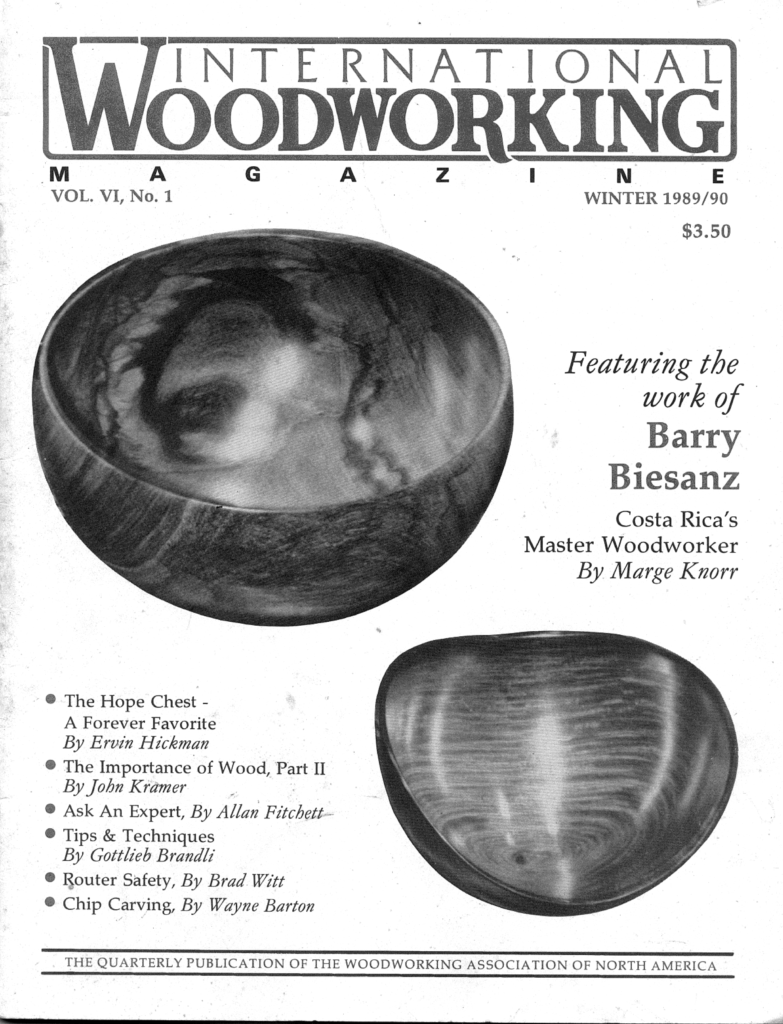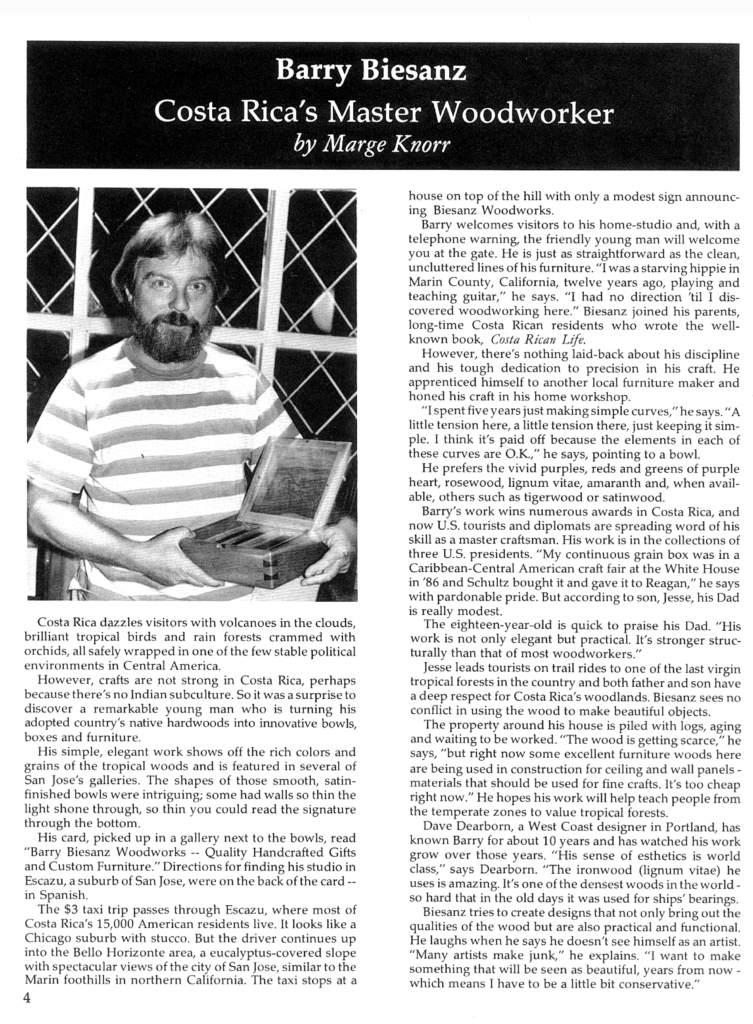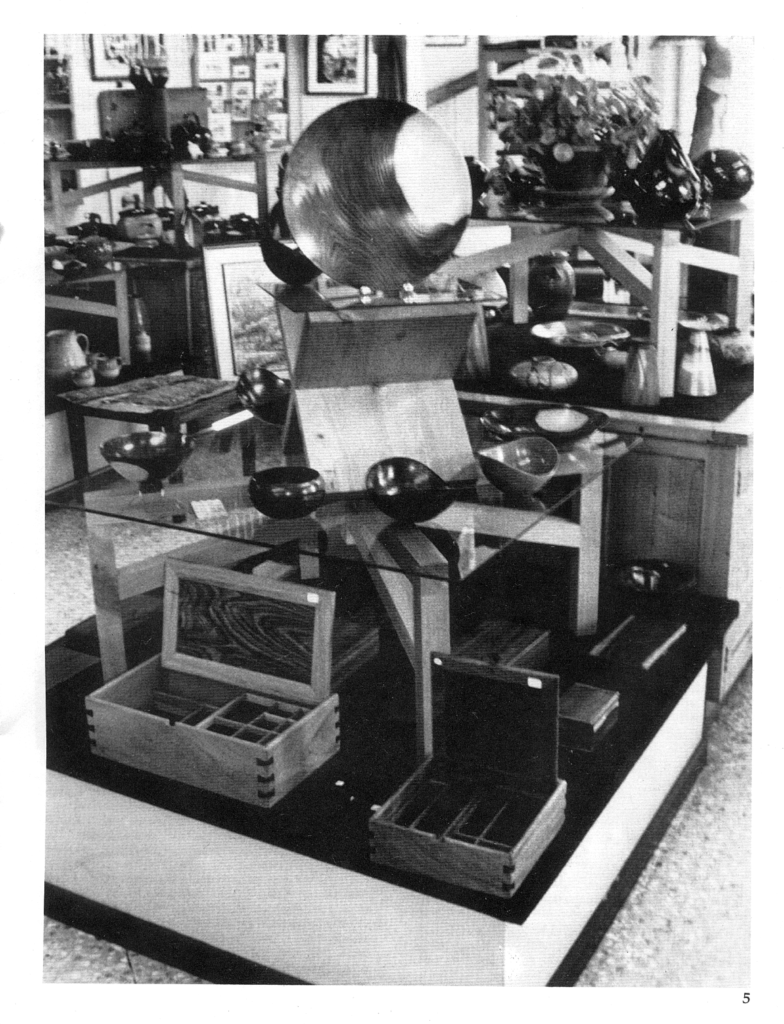Featuring the Work of Barry Biesanz, International Woodworking



International Woodworking Magazine
Vol VI, No. 1 Winter 1989/1990
$3.50
Featuring the Work of Barry Biesanz, Costa Rica’s Master Woodworker, by Marge Knorr
The Quarterly Publication of the Woodworking Association of North America
Costa Rica dazzles visitors with volcanoes in the clouds, brilliant tropical birds and rainforests crammed with orchids, all safely wrapped in one of the few stable political environments in Central America.
However, crafts are not strong in Costa Rica, perhaps because there is no Indian subculture. So it was a surprise to discover a remarkable young man who is turning his adopted country’s native hardwoods into innovative bowls, boxes and furniture.
His simple, elegant work shows off the rich colors and grains of the tropical woods and is featured in several of San Jose’s galleries. The shapes of those smooth, satin-finished bowls were intriguing; some had walls so thin the light showed through, so thin you could read the signature through the bottom.
His card, picked up in a gallery next to the bowls, read “Barry Biesanz Woodworks — Quality Handcrafted Gifts and Custom Furniture”. Directions for finding his studio in Escazú, a suburb of San José were on the back of the card – in Spanish.
The $3 taxi trip passes through Escazú, where most of Costa Rica’s 15,000 American residents live. It looks like a Chicago suburb with stucco. But the driver continues up into the Bello Horizonte area, a eucalyptus covered slope with spectacular views of the city of San José, similar to the Marin foothills in northern California. The taxi stops at a house on the top of the hill with only a modest sign announcing Biesanz Woodworks.
Barry welcomes visitors to his home studio and, with a telephone warning, the friendly young man will welcome you at the gate. He is just as straightforward as the clean, uncluttered lines of his furniture. “I was a starving hippy in Marin County, California, playing and teaching guitar,” he says. I had no direction ’til I discovered woodworking here. Biesanz joined his parents, long time Costa Rican residents who wrote the well known book Costa Rican Life.
However there is nothing laid back about his discipline and tough dedication to precision in his craft. He apprenticed himself to another local furniture maker and honed his craft in his home workshop.
“I spent five years just making simple curves,” he says. “A little tension here, a little tension there, just keeping it simple. I think it’s paid off because the elements in each of these curves is O.K.,” he says, pointing to a bowl.
He prefers the vivid purples, reds, and greens of purpleheart, rosewood, lignum vitae, amaranth, and when available, others such as tigerwood or satinwood.
Biesanz’ work wins numerous awards in Costa Rica, and now US tourists and diplomats are spreading word of his skill as a master craftsman. His work is in the collections of three US presidents. “My continuous grain box was in the Caribbean-Central American craft fair at the White House in ’86 and Schultz bought it and gave it to Reagan,” he says with pardonable pride. But according to son Jesse, his Dad is really modest.
The eighteen-year-old is quick to praise his Dad. “His work is not only elegant but practical. It’s stronger structurally than that of most woodworkers.”
Jesse leads tourists on trail rides to one of the last virgin tropical forests in the country and both father and son have a deep respect for Costa Rica’s woodlands. Biesanz sees no conflict in using the wood to make beautiful objects.
The property around the house is piled with logs, aging and waiting to be worked. “The wood is getting scarce,” he says, “but right now some excellent furniture woods here are being used in construction for ceiling and wall panels – materials that should be used for fine crafts. It’s too cheap right now.” He hopes his work will help teach people from the temperate zones to value tropical forests.
Dave Dearborn, a West Coast designer in Portland, has known Barry for about ten years, and has watched his work grow over those years. “His sense of esthetics is world class,” says Dearborn. The ironwood, (lignum vitae) he uses is amazing. It is one of the densest woods in the world – so hard that in the old days it was used for ships bearings.
Biesanz tries to create designs that not only bring out the qualities of the wood but are also practical and functional. He laughs when he says he doesn’t see himself as an artist. “Many artists make junk,” he explains. “I want to make something that will be seen as beautiful years from now. – which means that I have to be a little bit conservative.”
s
